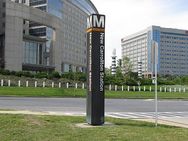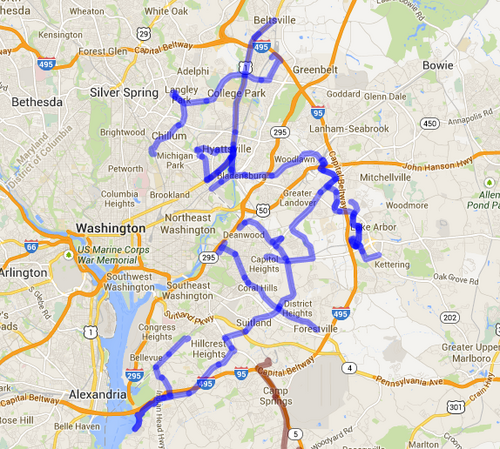How can Prince George’s grow in the right places?
At a recent town meeting, Prince George’s County planners asked where the county’s downtowns are. That meeting inspired me to think more broadly about where and how the county as a whole should grow in the coming years, which I look at in a new policy paper.
Titled “Plan Prince George’s 2035: Thinking and Growing Smartly Downtown and Beyond,” my paper is a response to Plan Prince George’s 2035, an ongoing update of the county’s General Plan. County planners envision most future growth taking place in a few “downtowns” around the county. Over the past year, they’ve hosted a town hall meeting for community members and released two reports of their own, Where and How We Grow and Typology and Prioritization.
But have planners selected the right areas for new downtowns, and should we focus on them at the expense of other areas? And will emphasis on “new towns” in greenfield areas undermine the plan’s goals? These are the issues I look at in my paper.
After reviewing the project team’s two reports and attending the town hall meeting at the University of Maryland along with 300 other community members, I initially had some questions about the criteria that the planners used to rank potential downtowns.
Their quantitative analysis tool gave a higher priority in the top 10 list to places like Cheverly, Suitland, and Riverdale, which aren’t really suitable for intense development, than to places that are, like Greenbelt and Largo. Other stations previously recognized as prime development opportunities, like Morgan Boulevard and Addison Road, didn’t show up anywhere in the top 10. It didn’t make sense to me that certain site-specific factors, such as the presence of available land for development and re-development and the absence of steep slopes, flood plains, and other barriers like railroad lines and highways, did not factor in more prominently in the diagnostic tool.
More broadly, though, I was concerned about what appeared to be a near-singular focus on the county’s “downtown”-capable Metro station areas, to the exclusion of other station areas. I was also concerned that the preliminary recommendation to include a “new town” center typology in the General Plan Update seemed to be tacitly endorsing the troubling concept of non-transit-oriented, outer-Beltway greenfield developments like Westphalia, which are contrary to the county’s stated land use priorities and basic smart growth principles.
Focus on the whole county, not just downtown
In Thinking and Growing Smartly, I attempt to more fully examine the questions posed by the M-NCPPC project team’s earlier two policy papers: where and how should we grow, and how should our transit stations interact with each other to form a coherent growth strategy? To reach those threshold questions, I explore a number of issues:
Change the classification of land: Today, Prince George’s County uses an amorphous, three-tier system to classify different parts of the county as either “Developed,” “Developing,” or “Rural.” The project team has sensibly indicated that it intends to adopt and implement the place categorization guidelines developed by the Maryland Department of Planning in connection with PlanMaryland, the statewide development plan.
Those guidelines classify land into one of five categories: Targeted Growth and Revitalization Areas, Established Community Areas in Priority Funding Areas, Future Growth Areas, Large Lot Development Areas, and Rural Resource Planning Areas.
I recommend that Targeted Growth and Revitalization Areas should cover only areas that are within: a 1/2-mile radius around around existing Metro and MARC rail stations, designated 1/2-mile districts along General Plan-designated transitways, and transit-accessible areas in designated Maryland Sustainable Communities and Maryland Enterprise Zones. Future Purple Line stations that aren’t in one of those areas already would become Future Growth Areas. All of those areas should be built under the county’s new form-based zoning requirements.
Define the place typologies: I generally agree with the planners that different place types belong in a hierarchy that describes the desired land use mix, housing and employment types and targets, and densities. However, the densities that county planners initially proposed are generally too low to support heavy and light rail. They also don’t distinguish between areas within 1/4 mile of a transit station, where densities should be highest, and areas within 1/4 and 1/2 mile.
I propose five distinct place typologies, each with their own recommended densities, most of which are higher than those originally proposed by the project team. In descending order, they are: Central Business Districts, Major Urban Districts, Neighborhood Urban Districts, Special Use/Employment Districts, and Transitway Districts.
Rethink greenfield sprawl: Rather than endorsing greenfield sprawl projects like Westphalia and Konterra by according them their own “new town” category, the county should rethink and rezone those areas before major development occurs there, which would further undermine the county’s transit-oriented development goals. Those land areas are not in a Priority Funding Area, Enterprise Zone, or Sustainable Community; therefore, they should be classified as either Large Lot Development Areas or Rural Resource Planning Areas.
Use Transitways to connect and revitalize the county: I also recommend 17 “Transitways” where the county should provide frequent bus service to connect major population centers to existing rail transit stations and major commercial and government centers.
Through the master planning process, the county should designate various Transitway Districts as focus areas for revitalization and intensive infill development. This would be a good solution for aging or deteriorated automobile-oriented commercial sites like Penn/Mar Shopping Center, Iverson Mall, and Langley Park Shopping Center.
Incentivize private sector development: I recommend that the county take a two-pronged approach to encourage more high quality jobs and development. First and foremost, the county should implement the necessary structural reforms that will foster a more sensible, faster, and less politicized development process. That includes placing appropriate restrictions on growth outside of targeted areas, streamlining the development review process, rewriting and simplifying the zoning ordinance, and eliminating the dreaded “council call-up” review of individual site plans.
Secondly, the county should focus public investment on those high-potential stations most in need of infrastructure improvement to catalyze private sector interest. Three good places to start would be New Carrollton, Addison Road, and Capitol Heights, which are older and less-prepared for new development than their counterparts on the Green Line and the Blue Line extension to Largo. They’ve also received less interest from public sector institutions, like the FBI or the University of Maryland Medical System’s new regional hospital, which could bring jobs that stimulate the local economy.
The planners need to hear from us
Recently, I had the pleasure of meeting with the M-NCPPC project team to discuss an earlier draft of my Thinking and Growing Smartly policy paper. Kierre McCune, lead coordinator on the Plan Prince George’s project, was happy to receive and discuss the paper, and noted that he was particularly pleased to see that at least someone outside of the Planning Department had taken the time to read through the project team’s prior materials and provide thoughtful feedback.
Similarly, planner Sonja Ewing remarked that citizens often don’t realize the value in providing this kind of feedback to the planners. She said it is helpful for the team to hear and be continually challenged by an outside-the-bubble perspective. And Planning Supervisor Kipling Reynolds said now was a good time for people to give input, since county planners are still refining their first draft of the Plan Update, which goes to the Planning Board in September.
What are your thoughts as to how Prince George’s can think and grow smartly? You can let county planners know by emailing them or following them on Twitter @PlanPGC2035. Even after it’s released, the public will still be able to offer suggestions. I hope that many of my recommendations will find their way into the draft as well.



